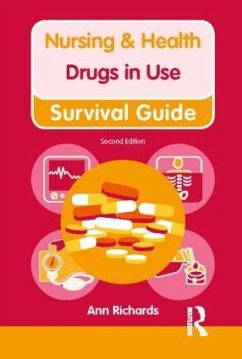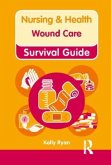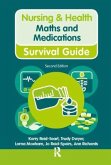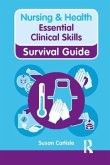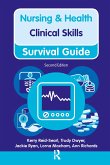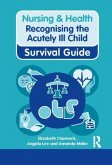Ann Richards
Drugs in Use
12,99 €
inkl. MwSt.
Versandfertig in über 4 Wochen

6 °P sammeln
Ann Richards
Drugs in Use
- Broschiertes Buch
- Merkliste
- Auf die Merkliste
- Bewerten Bewerten
- Teilen
- Produkt teilen
- Produkterinnerung
- Produkterinnerung
Understanding how drugs work is made simple in this easy to use pocket-sized guide. Drugs in common use are described under each body system and will form an aid to your confident administration of drugs to fit your patients' needs. The Nursing & Health Survival Guides have evolved - take a look at our our app for iPhone and iPad.
Andere Kunden interessierten sich auch für
![Nursing & Health Survival Guide: Wound Care Nursing & Health Survival Guide: Wound Care]() Kelly RyanNursing & Health Survival Guide: Wound Care12,99 €
Kelly RyanNursing & Health Survival Guide: Wound Care12,99 €![Maths and Medications Maths and Medications]() Kerry Reid-SearlMaths and Medications12,99 €
Kerry Reid-SearlMaths and Medications12,99 €![Essential Clinical Skills Essential Clinical Skills]() Susan CarlisleEssential Clinical Skills12,99 €
Susan CarlisleEssential Clinical Skills12,99 €![Clinical Skills Clinical Skills]() Kerry Reid-SearlClinical Skills12,99 €
Kerry Reid-SearlClinical Skills12,99 €![Antenatal Midwifery Skills Antenatal Midwifery Skills]() Alison EdwardsAntenatal Midwifery Skills12,99 €
Alison EdwardsAntenatal Midwifery Skills12,99 €![Recognising the Acutely Ill Child Recognising the Acutely Ill Child]() Elizabeth CharnockRecognising the Acutely Ill Child12,99 €
Elizabeth CharnockRecognising the Acutely Ill Child12,99 €![Labour Midwifery Skills Labour Midwifery Skills]() Alison EdwardsLabour Midwifery Skills12,99 €
Alison EdwardsLabour Midwifery Skills12,99 €-
-
-
Understanding how drugs work is made simple in this easy to use pocket-sized guide. Drugs in common use are described under each body system and will form an aid to your confident administration of drugs to fit your patients' needs. The Nursing & Health Survival Guides have evolved - take a look at our our app for iPhone and iPad.
Hinweis: Dieser Artikel kann nur an eine deutsche Lieferadresse ausgeliefert werden.
Hinweis: Dieser Artikel kann nur an eine deutsche Lieferadresse ausgeliefert werden.
Produktdetails
- Produktdetails
- Nursing and Health Survival Guides
- Verlag: Taylor & Francis Ltd
- 2 ed
- Seitenzahl: 88
- Erscheinungstermin: 17. September 2015
- Englisch
- Abmessung: 118mm x 86mm x 6mm
- Gewicht: 78g
- ISBN-13: 9780273763758
- ISBN-10: 027376375X
- Artikelnr.: 39219013
- Herstellerkennzeichnung
- Libri GmbH
- Europaallee 1
- 36244 Bad Hersfeld
- gpsr@libri.de
- Nursing and Health Survival Guides
- Verlag: Taylor & Francis Ltd
- 2 ed
- Seitenzahl: 88
- Erscheinungstermin: 17. September 2015
- Englisch
- Abmessung: 118mm x 86mm x 6mm
- Gewicht: 78g
- ISBN-13: 9780273763758
- ISBN-10: 027376375X
- Artikelnr.: 39219013
- Herstellerkennzeichnung
- Libri GmbH
- Europaallee 1
- 36244 Bad Hersfeld
- gpsr@libri.de
Ann Richards
INTRODUCTION
Some classes of drugs
Common abbreviations used in drug administration
Latin abbreviations
Routes of administration
Units used in drug administration
Recognised drug abbreviations
Other common abbreviations
SOME DEFINITIONS ROUTES OF DRUG ADMINISTRATION
Oral administration Intravenous drug administration
Drug absorption, distribution, metabolism and elimination
Absorption
Drug distribution
Drug metabolism and elimination
Mechanisms of drug action - pharmacodynamics
Drug receptors
Some drugs affecting adrenergic transmission
Drugs and the respiratory tract Bronchodilators
Other drugs used in asthma
Steroids (glucocorticoids, corticosteroids
Cardiovascular drugs
Nitrates
Calcium channel blockers
Alpha adrenoreceptor antagonists
Potassium channel activators
ACE-Inhibitors
Angiotensin-II receptor antagonists
Drugs affecting cardiac contractility Digoxin
Adrenaline Atropine
Beta-adrenergic antagonists (beta-blockers)
Antiarrhythmic drugs
Vaughan Williams classification of antidysrhythmic drugs
Examples of drugs used for specific cardiac arrhythmias
Lipid-lowering drugs
Statins
Fibrates
NICE guidance to choice of drug treatment for newly diagnosed hypertension
Prevention of CVD Chronic heart failure Antithrombotics Anticoagulants
Antiplatelet drugs
Thrombolytic agents
Diuretics Urinary incontinence Gastrointestinal tract AntiEmetics
Analgesics
Paracetamol NSDAIDs
Opioids
Drugs to treat diabetes mellitus
The different actions of various types of insulin
Oral hypoglycaemic agents and their action
Some antibacterial drugs The central nervous system
Drugs commonly used to prevent seizures in epilepsy
Parkinson's disease
Alzheimer's disease and other forms of dementia
ANTIDEPRESSANTS HYPNOTICS ANTIPSYCHOTIC DRUGS ADVERSE DRUG REACTIONS
Predisposing factors
Examples of ADRs
Adverse drug events
Some prescribing and administration errors
Possible causes of prescribing and administration errors
Preventing errors
Drug and food interactions
Some differentiating features of drug overdose
Drugs causing coma
Drugs affecting pupil size
Drugs causing respiratory features
Cardiovascular features
Common drug overdoses
Useful websites
Some classes of drugs
Common abbreviations used in drug administration
Latin abbreviations
Routes of administration
Units used in drug administration
Recognised drug abbreviations
Other common abbreviations
SOME DEFINITIONS ROUTES OF DRUG ADMINISTRATION
Oral administration Intravenous drug administration
Drug absorption, distribution, metabolism and elimination
Absorption
Drug distribution
Drug metabolism and elimination
Mechanisms of drug action - pharmacodynamics
Drug receptors
Some drugs affecting adrenergic transmission
Drugs and the respiratory tract Bronchodilators
Other drugs used in asthma
Steroids (glucocorticoids, corticosteroids
Cardiovascular drugs
Nitrates
Calcium channel blockers
Alpha adrenoreceptor antagonists
Potassium channel activators
ACE-Inhibitors
Angiotensin-II receptor antagonists
Drugs affecting cardiac contractility Digoxin
Adrenaline Atropine
Beta-adrenergic antagonists (beta-blockers)
Antiarrhythmic drugs
Vaughan Williams classification of antidysrhythmic drugs
Examples of drugs used for specific cardiac arrhythmias
Lipid-lowering drugs
Statins
Fibrates
NICE guidance to choice of drug treatment for newly diagnosed hypertension
Prevention of CVD Chronic heart failure Antithrombotics Anticoagulants
Antiplatelet drugs
Thrombolytic agents
Diuretics Urinary incontinence Gastrointestinal tract AntiEmetics
Analgesics
Paracetamol NSDAIDs
Opioids
Drugs to treat diabetes mellitus
The different actions of various types of insulin
Oral hypoglycaemic agents and their action
Some antibacterial drugs The central nervous system
Drugs commonly used to prevent seizures in epilepsy
Parkinson's disease
Alzheimer's disease and other forms of dementia
ANTIDEPRESSANTS HYPNOTICS ANTIPSYCHOTIC DRUGS ADVERSE DRUG REACTIONS
Predisposing factors
Examples of ADRs
Adverse drug events
Some prescribing and administration errors
Possible causes of prescribing and administration errors
Preventing errors
Drug and food interactions
Some differentiating features of drug overdose
Drugs causing coma
Drugs affecting pupil size
Drugs causing respiratory features
Cardiovascular features
Common drug overdoses
Useful websites
INTRODUCTION
Some classes of drugs
Common abbreviations used in drug administration
Latin abbreviations
Routes of administration
Units used in drug administration
Recognised drug abbreviations
Other common abbreviations
SOME DEFINITIONS ROUTES OF DRUG ADMINISTRATION
Oral administration Intravenous drug administration
Drug absorption, distribution, metabolism and elimination
Absorption
Drug distribution
Drug metabolism and elimination
Mechanisms of drug action - pharmacodynamics
Drug receptors
Some drugs affecting adrenergic transmission
Drugs and the respiratory tract Bronchodilators
Other drugs used in asthma
Steroids (glucocorticoids, corticosteroids
Cardiovascular drugs
Nitrates
Calcium channel blockers
Alpha adrenoreceptor antagonists
Potassium channel activators
ACE-Inhibitors
Angiotensin-II receptor antagonists
Drugs affecting cardiac contractility Digoxin
Adrenaline Atropine
Beta-adrenergic antagonists (beta-blockers)
Antiarrhythmic drugs
Vaughan Williams classification of antidysrhythmic drugs
Examples of drugs used for specific cardiac arrhythmias
Lipid-lowering drugs
Statins
Fibrates
NICE guidance to choice of drug treatment for newly diagnosed hypertension
Prevention of CVD Chronic heart failure Antithrombotics Anticoagulants
Antiplatelet drugs
Thrombolytic agents
Diuretics Urinary incontinence Gastrointestinal tract AntiEmetics
Analgesics
Paracetamol NSDAIDs
Opioids
Drugs to treat diabetes mellitus
The different actions of various types of insulin
Oral hypoglycaemic agents and their action
Some antibacterial drugs The central nervous system
Drugs commonly used to prevent seizures in epilepsy
Parkinson's disease
Alzheimer's disease and other forms of dementia
ANTIDEPRESSANTS HYPNOTICS ANTIPSYCHOTIC DRUGS ADVERSE DRUG REACTIONS
Predisposing factors
Examples of ADRs
Adverse drug events
Some prescribing and administration errors
Possible causes of prescribing and administration errors
Preventing errors
Drug and food interactions
Some differentiating features of drug overdose
Drugs causing coma
Drugs affecting pupil size
Drugs causing respiratory features
Cardiovascular features
Common drug overdoses
Useful websites
Some classes of drugs
Common abbreviations used in drug administration
Latin abbreviations
Routes of administration
Units used in drug administration
Recognised drug abbreviations
Other common abbreviations
SOME DEFINITIONS ROUTES OF DRUG ADMINISTRATION
Oral administration Intravenous drug administration
Drug absorption, distribution, metabolism and elimination
Absorption
Drug distribution
Drug metabolism and elimination
Mechanisms of drug action - pharmacodynamics
Drug receptors
Some drugs affecting adrenergic transmission
Drugs and the respiratory tract Bronchodilators
Other drugs used in asthma
Steroids (glucocorticoids, corticosteroids
Cardiovascular drugs
Nitrates
Calcium channel blockers
Alpha adrenoreceptor antagonists
Potassium channel activators
ACE-Inhibitors
Angiotensin-II receptor antagonists
Drugs affecting cardiac contractility Digoxin
Adrenaline Atropine
Beta-adrenergic antagonists (beta-blockers)
Antiarrhythmic drugs
Vaughan Williams classification of antidysrhythmic drugs
Examples of drugs used for specific cardiac arrhythmias
Lipid-lowering drugs
Statins
Fibrates
NICE guidance to choice of drug treatment for newly diagnosed hypertension
Prevention of CVD Chronic heart failure Antithrombotics Anticoagulants
Antiplatelet drugs
Thrombolytic agents
Diuretics Urinary incontinence Gastrointestinal tract AntiEmetics
Analgesics
Paracetamol NSDAIDs
Opioids
Drugs to treat diabetes mellitus
The different actions of various types of insulin
Oral hypoglycaemic agents and their action
Some antibacterial drugs The central nervous system
Drugs commonly used to prevent seizures in epilepsy
Parkinson's disease
Alzheimer's disease and other forms of dementia
ANTIDEPRESSANTS HYPNOTICS ANTIPSYCHOTIC DRUGS ADVERSE DRUG REACTIONS
Predisposing factors
Examples of ADRs
Adverse drug events
Some prescribing and administration errors
Possible causes of prescribing and administration errors
Preventing errors
Drug and food interactions
Some differentiating features of drug overdose
Drugs causing coma
Drugs affecting pupil size
Drugs causing respiratory features
Cardiovascular features
Common drug overdoses
Useful websites
